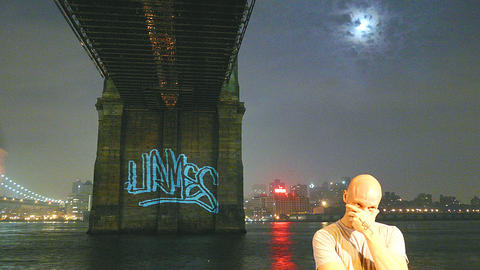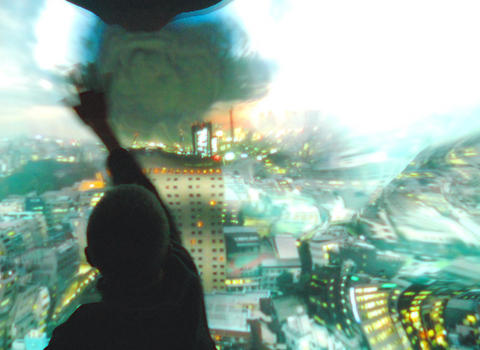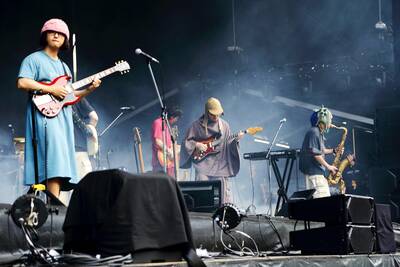G raffiti artists need fear the law no longer - at least that's the word on the street in New York. Two artists versed in "tagging" have come up with a state-of-the-art computer program that enables graffiti writers to replace spray paint with light using a camera, laptop and projector. Combined, artists can project graffiti onto the side of a building. And in the spirit of the creator's open-source ethos, the code for the program, L.A.S.E.R. Tag, is posted online for enthusiasts and artists to "download, dissect, reuse and hopefully improve," according to Graffiti Research Lab's (GRL) Web site (www.graffitiresearchlab.com).
GRL's program is one of the many creations going on display tomorrow as part of Openplay Digital Art Festival in Taipei that runs until Dec. 2 at the Red House Theater (紅樓劇場) in Ximending (西門町).
The participating artists are known as much for their technological prowess as they are for their art. Many of the projects began as research and were then developed into art or, in some cases, for commercial use. And although it required considerable technical skill to create the works - some of the artists have PhDs in computer science or engineering - the creations are relatively simple to understand and manipulate.

PHOTO: COURTESY OF THE DIGITAL ART FESTIVAL
For Valentina Vuksic's installation, Harddisko, the artist gathered 16 defective PC hard disks, removed the casings and connected them to a sound mixer using simple electric circuits. As soon as the power is turned on, the disks move in specific patterns and generate sound. The result can be compared to an orchestra of various instruments.
Like Harddisko, Interactive Sonic Systems' ReacTable is a digital musical instrument. It consists of a round table set with illuminated plastic picture tiles. Each one generates a specific sound or modifies sound in some way. Visitors play it by arranging and rearranging the tiles, producing a variety of sounds. The ReacTable also provides visual feedback on the table.
Instead of playing with sound, Alvaro Cassinelli's The Khronos Projector allows viewers to explore prerecorded movie content in new ways. Rather than viewing a movie chronologically, the user is able to send parts of the image forward or backward in time by touching the projection screen. For example, the image of a daytime cityscape becomes, at the point where the hand or finger moves along the surface of the screen, dusk and eventually evening. As soon as the viewer's hand is lifted, the screen returns to the daytime scene.

PHOTO: COURTESY OF THE DIGITAL ART FESTIVAL
The Robotic Chair by Canadian artists Raffaello d'Andrea, Max Dean and Matt Donovan, falls apart and puts itself back together. Watching the wooden, classroom chair spontaneously fall apart and gradually reassemble itself is a surreal experience, and seems to be a statement about the ability of humans to do the same.
Contemporary art, it would seem, has split into two parts: that which is looked at and contemplated and that which is played with and manipulated. The works at the second Digital Art Festival fall into the latter category and visitors should be fascinated, regardless of what their definition of art is.

PHOTO: COURTESY OF THE DIGITAL ART FESTIVAL

No one saw it coming. Everyone — including the Chinese Nationalist Party (KMT) — expected at least some of the recall campaigns against 24 of its lawmakers and Hsinchu Mayor Ann Kao (高虹安) to succeed. Underground gamblers reportedly expected between five and eight lawmakers to lose their jobs. All of this analysis made sense, but contained a fatal flaw. The record of the recall campaigns, the collapse of the KMT-led recalls, and polling data all pointed to enthusiastic high turnout in support of the recall campaigns, and that those against the recalls were unenthusiastic and far less likely to vote. That

Behind a car repair business on a nondescript Thai street are the cherished pets of a rising TikTok animal influencer: two lions and a 200-kilogram lion-tiger hybrid called “Big George.” Lion ownership is legal in Thailand, and Tharnuwarht Plengkemratch is an enthusiastic advocate, posting updates on his feline companions to nearly three million followers. “They’re playful and affectionate, just like dogs or cats,” he said from inside their cage complex at his home in the northern city of Chiang Mai. Thailand’s captive lion population has exploded in recent years, with nearly 500 registered in zoos, breeding farms, petting cafes and homes. Experts warn the

A couple of weeks ago the parties aligned with the People’s Republic of China (PRC), the Chinese Nationalist Party (KMT) and the Taiwan People’s Party (TPP), voted in the legislature to eliminate the subsidy that enables Taiwan Power Co (Taipower) to keep up with its burgeoning debt, and instead pay for universal cash handouts worth NT$10,000. The subsidy would have been NT$100 billion, while the cash handout had a budget of NT$235 billion. The bill mandates that the cash payments must be completed by Oct. 31 of this year. The changes were part of the overall NT$545 billion budget approved

Before performing last Friday at Asia’s bellwether music festival, Fuji Rock in Japan, the Taiwanese indie band Sunset Rollercoaster (落日飛車) had previously performed on one of the festival’s smaller stages and also at Coachella, the biggest brand name in US music festivals. But this set on Fuji Rock’s main stage was a true raising of the bar. On a brilliant summer’s evening, with the sun rays streaming down over a backdrop of green mountains and fluffy white clouds, the performance saw the Taiwanese groovemasters team up with South Korean group Hyukoh, with whom they’ve formed a temporary supergroup called AAA